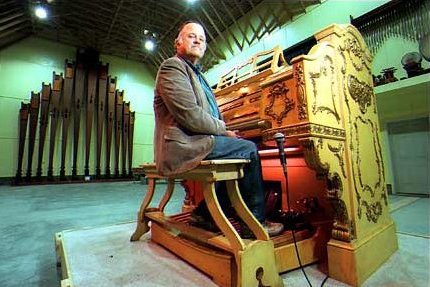


Gould Studio - 3/28 Wurlitzer
The Gould Studio instrument is based around a Balaban 3, French style with 15 ranks:
**
Maple Valley, Washington
Back to the Private Residence Installations page
Brass Trumpet, Tuba Horn, Diaphonic Diapason, Tibia Clausa, Clarinet, Oboe Horn, Orchestral Oboe, Kinura, Saxophone, Salicional, Quintadena, Viol d'Orchestre, Viol Celeste, Concert Flute, Vox Humana.
Added ranks include: Quintadena, Flute, Vox, Trumpet, VDO and Celeste, 3 Violins, Post Horn,
Tibia, 16' Oboe, 16' Bombarde and 16' Double Open. The second harp is a very rare Wurlitzer metal harp. The 12 notes of the Double Open 16 are the only pipes that aren't Wurlitzer.
The following picture and text are from a Jon Hahn article in the Seattle Post-Intelligencer
newspaper, Saturday October 17, 1998:

Jerry Gould sits at the console of his vintage Wurlitzer pipe organ, which he houses inside a big
barn at his home in Maple Valley. (Photo by Meryl Schenker). Note 32' Diaphones in background.
Pilot's pipe dream is realized with organ fit for an orchestra
Not far off the Maple Valley Highway sits a gentle giant that, when roused, can shake the valley floor with powerful tremors or whisper musical notes as sweet as songbirds.
Far removed from its urban origins but even more powerful in its pastoral setting, the mighty Tahoma Wurlitzer theater pipe organ is Maple Valley's own noteworthy cultural icon. With pipes weighing from a quarter ounce to a quarter ton, it can, in the words of owner Jerry Gould, "whisper, or grab you by the shirt and shake you!"
At the hands of internationally acclaimed keyboard artist Walter Strony last weekend, the organ enchanted and excited a disparate philharmonic audience drawn to Jerry and Mary Gould's place in the woods.
Many first heard this 1920s vintage organ when it was the centerpiece of the old Pizza & Pipes in Seattle's Greenwood nieghborhood. But since Gould, a Northwest Airlines 747 captain, acquired the organ, it has grown several fold in orchestral capacity.
In a 100-by-100-foot building with a 40-foot-high ceiling -- a space large enough to house a blimp -- Gould and Greg Smith, another former Pizza & Pipes fixture, have spent several years and a goodly amount of money and sweat rebuilding and expanding the Wurlitzer.
At an intentional distance, a very understanding Mary Gould set up refreshments for the audience as she observed that she doesn't "read a note of music, or have anything to do with this organ project . . . but that's what makes our marriage work: We support one another's work and interests."
Mary is an ordained Episcopal minister and director of mission, integration and pastoral care at the Providence Marianwood Care Center in Issaquah. She quipped that there was a time, earlier in their marriage, when Jerry's fascination with pipe organs had their marriage in a corner. "He had a smaller pipe organ in the house, and he had a habit of playing it at night, when it rattled the windows! So we negotiated."
It was simple. Jerry bought the even larger Wurlitzer from Smith, who had it in storage, and built the huge barnlike building around it. Now, when he's not flying, he's either working on the organ or playing it. "I started piano lessons when I was in the second grade, growing up in Colville, and I considered music as a career," he said. But he ended up as an Air Force pilot in Vietnam and the Air National Guard, and began flying for Northwest in 1968.
He bought the huge Wurlitzer about 1980.
"I've been adding to it ever since. The original instrument is about doubled in size and the project is about one-third complete. But as it is now, I'll put it up against any theater organ in the country for tonal quality.
"A church pipe organ is like a piano, compared to a theater organ. Theater organs were originally called 'unit orchestras,' and they were used to substitute for live pit orchestras accompanying silent movies. So a theater organ can be a solo instrument or the whole orchestra. Like an orchestra, you have only so many 'voices' available. A small concert orchestra with say, 30 instruments, might have only one contrabass. But a large one might have six, which enables you to play a broader scope of music. Beethoven's Fifth doesn't begin to sound good on a pipe organ till you have one this size."
There is a striking comparison between the pipe organ console and what you might imagine as Gould's 747 control panel. And each is controlled, as Gould remarked to the concert audience, usually with the operator's back to the people. Although each requires sharply honed hand-eye coordination, the similarity ends there.
With 28 ranks (distinct "voice" sets) of pipes -- and more to be added -- this Wurlitzer is among the largest on the West Coast, according to Smith, of Bothell, who is both an organist and organ technician. "This organ originally was Wurlitzer No. 2121 -- out of a total 2,238 built by the Wurlitzer Co. from 1911 to 1943. It has thousands of moving parts that need constant tuning, with attention to temperature, humidity and other conditions.
"It was originally built for the Paramount Theatre in Salem, Mass., in 1930, and was reinstalled and played at the Two electric forced-air blowers, with combined 45 horsepower, provide the air to drive several different chambers -- high-ceilinged rooms along one side of the building -- that house the various ranks. The sound plays into the huge main room through a series of controlled vertical shutters at the top of each chamber.
The chambers are heated and/or air-conditioned and humidity-controlled, but the huge main room is not. "In the winter, I have a little sort of insulated 'box' that goes around the console to warm and protect it," Jerry said. "But I can open the top of the box and get inside and play it."
Exposed at one end of the huge main room is a complete rank of 32-foot wooden diaphone organ pipes originally rescued from the old Tivoli Theater in Chicago. Jerry bought the set from David Packard (Hewlett-Packard founder), who had hoped to use them in another pipe organ restoration. Three years of work by Jerry, Greg and others went into restoring these huge, Low-C earth-shakers. **
"There is nothing electronic about it, no solid-state, digitized anything. This is completely acoustic!" Greg emphasized.
This completely acoustic beast might rattle windows in Enumclaw and register on the University of Washington
seismology sensors if Jerry Gould really cranked it up. But he still must remember that the Rev. Mary Gould don't allow no window-rattling in her Maple Valley home.
Jon Hahn is a staff columnist who writes three times a week in the P-I.
![]() Editor's note: These large pipes were previously installed in Tommy Stark's
Organ Power Pizza restaurant in
Lemon Grove, California (near San Diego).
Editor's note: These large pipes were previously installed in Tommy Stark's
Organ Power Pizza restaurant in
Lemon Grove, California (near San Diego).
About this site © PSTOS, 1998-2004